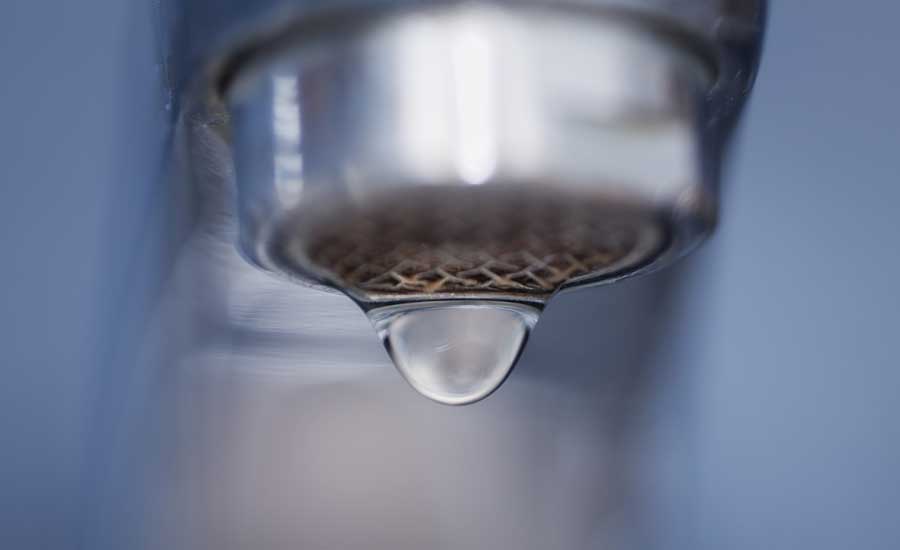Potable water is a real commodity these days. Although more than 70% of the earth’s surface is covered with water, only about 2.5% actually is suitable for human consumption. A renewable resource, fresh water restores itself solely through evaporation and precipitation. And as drought spreads across the globe — from the southwestern U.S. to India and the Middle East — the focus turns toward preservation.
And yet water conservation is nothing new. The first federal legislation on the topic dates back to the 1992 U.S. Energy Policy Act — still the national standard for plumbing fixtures today — that cut the traditional 3.5 gpf down to 1.6 gpf. States such as California recently have set higher efficiency standards, mandating that all faucets installed not exceed 1.2 gpm flow and toilets not exceed 1.28 gpf.
At the same time, third-party certification systems have created an organized, voluntary standard for water conservation and made it fashionable for commercial buildings to earn accreditation. From the most notable, the USGBC’s LEED Rating System, to the WELL Building Standard, Green Globes, Estidama and Net Zero Energy Buildings (NZEB), today’s rating systems have become a new benchmark more than even a prized endorsement.
Unfortunately, in their noble quest to conserve water, these standards have inadvertently led to additional building complications as they relate to overall plumbing system design and performance. Dictating water consumption at the fixture level only, today’s efficient rating standards force engineers to rethink back-of-house plumbing infrastructure design that encourages both true water savings and continued, sustainable operations. With the right engineering know-how, plumbing infrastructure and accurately specified fixtures, sustainable standards can still succeed in today’s buildings.
Fixture operation
For low-flow fixtures to deliver the same performance as an older fixture, a higher pressure supply is required at the fixture. For example, a toilet flush valve operating at 3.5 gpf used to work on 15 to 20 psi. Now, 1.6 gpf and lower flush valves need a supply pressure between 25 and 30 psi to achieve the pressure necessary to move waste out of the system. While this may not be a big deal for residences or commercial buildings three stories or less, getting an extra 10 pounds of pressure at the top of a downtown high rise could add significant capital costs to a project. For this reason, special attention must be paid to cold water supply systems serving urinals and toilets when it comes to low-flow fixtures to achieve the desired results.
-
Hot water supply and return systems: Simply put, low-flow fixtures require more time to get hot water to the consumer from the source. Flushing out uncirculated hot water supply lines takes time and the lower the flow rate, the longer the flushing time takes. For example, a 3/4-in. hot water supply to a sink, featuring a traditional 2-gpm aerator on the faucet can be as far as 44 ft. away from its hot water source and still procure hot water for the occupants in just 30 seconds. When this flow rate is cut in half to 1-gpm, the source must be 22 ft. closer to the faucet to maintain the same 30 seconds of wait time for hot water. The latter requires an extra 22 ft. of piping and a balancing valve to achieve the same “time to hot water.” This necessitates additional hot water return branches, balancing valves and cost to systems that in the past have not been as complicated.
Third-party certifications are well intended, but perhaps unintentionally have opened a window to performance issues in the name of water savings.
For this reason, low-flow aerators should be specified in locations where they won’t irritate occupants. For example, when specified in task locations — at showers, kitchen sinks, etc. — low-flow faucets will take up to double the amount of time to achieve the same results, such as rinsing hair or filling a coffee pot. Although all that is required to achieve the water conservation designation from a third-party certification is to specify and install the low-flow faucets, in task applications they likely won’t actually achieve the ultimate goal of saving water.
-
Urinals: Using low-flow urinals — or a lower amount of water to evacuate the waste from a urinal — leaves a higher concentration of urine in the wastewater stream. Where this is the case, the wastewater becomes more acidic and can be corrosive to a building’s metal piping. In some cases, this could even result in deterioration of the vent system serving the waste piping. Vent piping assumes a lot of evaporation from the waste stream, which can corrode the piping from the inside out, especially when made of metal. This problem is further heightened with waterless urinals where there’s no method of cleaning the urinal after each usage. In this case, foul odors may overtake a bathroom.
-
Toilets: While the current federal baseline, established by the 1992 U.S. Energy Policy Act, remains 1.6 gpf, there is a real trend to move this standard to 1.28 gpf, a push from toilet manufacturers, and building owners and operators alike who are looking to champion water conservation.
The biggest challenge here is the capability of a 1.28 gpf toilet to carry solid waste down a horizontally-pitched waste pipe. ASME A112.19.2, which sets minimum performance requirements for toilets regardless of flush volume, requires waste pipe to be carried 40 feet based on an average amount of flushes during the performance test. While the higher flush rate toilets easily can carry waste more than 40 ft., today’s low-flow fixtures are highly engineered to meet this standard. This has resulted in great consideration by plumbing engineers to understand where water closets are located in relation to building stacks and main lines carrying larger waste streams.
Another important function of flushing is to cleanse the bowl. While the 1.6 gpf likely will evacuate the bowl, it won’t clean it the same way the 3.5-gpf fixture once did. And the 1.28-gpf toilet will make it even harder to get the bowl clean. Where this is the case, the occupant typically will flush a second time. Now, the low-flow flush used 3.2 gallons or 2.56 gallons, respectively.
User satisfaction shouldn’t be discounted
A building owner or operator considering specifying low-flow fixtures should ask themselves the following questions:
-
How long are occupants willing to wait for hot water?
-
Will the low-flow toilets need additional plumbing infrastructure support to operate effectively?
-
Will the facilities personnel need to rot out the plumbing lines more often with low-flow fixtures?
-
What are other potential repercussions of specifying low-flow fixtures?
While the answer to some of these questions will be universal to all buildings, many will be specific to market or industry. Customer-service-focused facilities such as retail and hospitality, or medical facilities such as hospitals and doctor’s offices, likely will have very different water needs and demands than a commercial office building or residential property.
Third-party certifications are well intended, but perhaps unintentionally have opened a window to performance issues in the name of water savings. To solve this conundrum, fixture manufacturers continuously are striving to improve the design of low-flow fixtures so they will gain better traction. Until then, there is a chance that a building’s plumbing system performance and user satisfaction may suffer without the proper insight of low-consumption fixtures by the plumbing engineer.
One new and one retrofit building reveal specifying low flow fixtures isn’t fluid
Building A: New 25-floor medical office building in the Midwest.
Problem: Building A experienced major problems with its 1.28-gpf low-flow toilets in the first year of operations. With some installations having more than 100 ft. of horizontal waste run from its toilet rooms to the building’s vertical stack, maintenance personnel had to rot out each toilet multiple times a week just to maintain normal function.
Solution: A building infrastructure analysis determined that more vertical stacks were needed to shorten the length of carry from the toilets to the main stack. The building was retrofitted accordingly.
Takeaway: The original plumbing designers overlooked the necessary plumbing infrastructure needed to support 1.28-gpf low-flow toilets.
Building B: Existing 20-plus story high-rise office building in Chicago.
Problem: Building B recently was renovated to meet LEED for Existing Buildings certification criteria. This included installing 0.5-gpm low-flow fixtures where 2-gpm fixtures previously existed at task applications. Occupants were unable to complete normal functions of daily living in the same way, such as filling coffee pots and washing dishes.
Solution: Building infrastructure analysis revealed the most viable solution was to renovate the back-of-house plumbing infrastructure to meet the needs of the low-flow faucets, as in the Building A example. Due to budget constraints, the ownership ultimately decided to remove the low-flow faucets and replace with mid-level flow rate faucets that were not as ambitious in water savings.
Takeaway: If you’re going to retrofit an existing building with low-flow fixtures, do your homework and understand the end- user application for the fixture to design the right solution.
Four tips for designing with low-flow plumbing fixtures
When designing plumbing systems for new and retrofit construction in conjunction with a third-party efficiency rating standard, make sure you consider the following:
1) Pay attention to the flow rate at the fixture. Make sure you have designed the back-end hot water system accurately.
2) Are you bringing the hot water return loop as close to the fixture as possible to maintain a reasonable time to acclimate to hot water?
3) Low-flush volume toilets must meet certain carry distances to be ASME certified. Because the test criteria doesn’t necessarily reflect real world scenarios, verify that a vertical system is within the carry distance to avoid clogging the waste pipe.
4) When specifying mixing valves for a public lavatory or shower, make sure to specify mixing valves listed at the same low-flow rate as the fixture. When mixing valves aren’t competent with the lavatory or shower, shower valves may not operate as intended or people can get burned.




